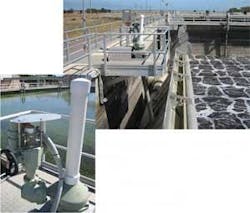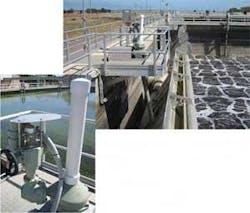AUMA success with SBR decant weirs
Pat Gordon, who represents Barron GJM Pty. Ltd., a supplier of AUMA actuation solutions in Sydney, Australia, reports on the company’s success supplying drives to sequencing batch reactor (SBR) decant weirs.
by Michael Herbstritt
A campaign to educate the water sector to the advantages of AUMA’s intermittently rated drive which meets the needs of the continuously rated application of the decant was initiated by Barron in the 1990s. Today, the company has supplied nine of the country’s most prestigious wastewater treatment works (WwTWs) with solutions for SBR decant weir applications.
Among the WwTWs supplied with AUMA technology for SBR decant weirs are three Australian plants. SA Water’s AU$100 million Bolivar Environment Improvement Program (EIP) represents a significant investment in the environment for the future benefit of all South Australians. The plant was completed in September 1999 and now provides treated wastewater suitable for direct irrigation – the Bolivar scheme contains 12 weirs.
Mackay Water is a commercialised business unit of Mackay City Council providing water and sewerage services to residential, commercial/industrial customers – 14 weirs are incorporated within its two major WwTWs.
The third Australian reference site for AUMA SBR decant weir drives is at Woodman Point south of Perth which was upgraded in 2002 to increase capacity to 160 million litres of water a day. The new works feature a secondary treatment process to improve effluent quality including reducing the quantity of nitrogen in the treated water to make it suitable for industrial reuse. The Woodman Point plant occupies 82 hectares of land in a natural bushland setting – the works contains 34 weirs.
Commenting on the challenges placed on the actuator drives, and drawing on the examples of the three reference sites listed above, Pat Gordon said: “The duty cycle of the weirs at Bolivar, Mackay and Woodman Point is that the drive must lower the weir during 80 minutes and then elevate it over 60 minutes. This occurs four times per day. As a result, the actuator is required to do 2,000 revolutions for the downward movement and 2,000 revolutions upward. Four daily cycles of 4,000 revolutions equates to 16,000 revolutions a day and totals 5.8 million revolutions a year.
“Water Engineers De Vos Chater and Associates of Perth conducted thorough tests of weirs and determined the forces present in the drive mechanism. Results showed a typical weir experiences substantial positive and negative load reversals during each and every stroke – this requires as much as 900 Nm of torque.
“Consistently high mechanical loads present the main challenge to actuation suppliers for the SBR decant weir market. In supplying the AUMA solution, the company’s engineers addressed this requirement and incorporated a high safety factor into the technology. AUMA’s modular product portfolio with high torque range provides tailor made solutions with a long service life.
“For the applications mentioned in this report, multi-turn AUMA SA actuators have been supplied with GK bevel gearboxes. The gearing components are lubricated with a complex high-tech grease selected specifically for this application and, depending on the environmental conditions of the works, actuators/gearboxes are equipped with high corrosion protection.
“Meeting the demand of variable output speeds for the decants, Danfoss variable-frequency drive (VFD) controllers have been provided by the client’s engineers for the SBR decant weir applications.”
Barron provides complete engineering solutions incorporating AUMA actuation technology across a range of water treatment applications. The SBR decant weir solution is predicted to continue as a major growth area, with increasing numbers of utilities recognising the benefits of its high torque capabilities. Engineering expertise and application knowledge are cited as key to the success of the solution.
Author’s Note:
Michael Herbstritt is a technical writer for AUMA Riester GmbH & Co. KG, of Muellheim, Germany –
www.auma.com
Enquiry No. 200

